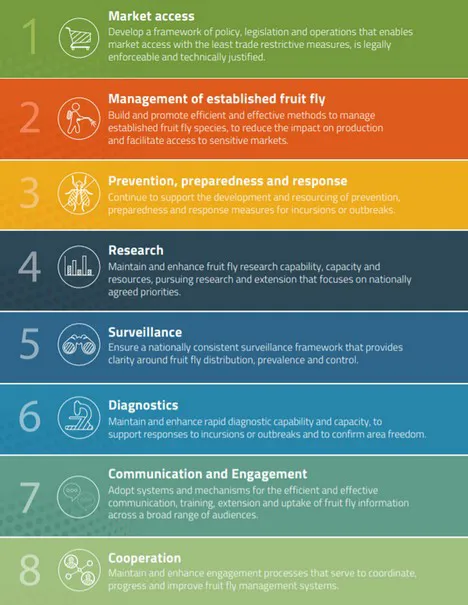The National Fruit Fly Council (NFFC) has released the 2020-25 National Fruit Fly Strategy, providing a framework for governments, industry and research funders to advance fruit fly management in Australia.
The strategy was launched late last week, with NFFC Chair Lloyd Klump noting that everyone had a responsibility when it came to managing fruit flies in Australia.
“While it is the Council which will oversee the implementation of the strategy, our real strength lies in the contribution that every individual and every organisation makes to combating fruit fly,” Lloyd said.
“Effective management of fruit flies relies on cooperation at all levels of government, and between industry bodies, research institutions, regional groups, growers, and community and home gardeners.
“To this end, I encourage everyone to consider using this strategic framework when planning and executing fruit fly management.”
“It is a blueprint for national cooperation as we seek to both manage our existing pest fruit fly species, Queensland fruit fly and Mediterranean fruit fly, and prevent exotic species like Oriental fruit fly establishing in Australia.”
Fruit flies have had a major impact on apple and pear growing over the years, and estimates value damage to the entire horticulture industry at around $300 million per year. They are also a major barrier to market access in impacted areas.
There are generally increases in population during spring, with most activity noted during summer when temperatures are suitable. Apple and pear growers are encouraged to use bait sprays, covers and traps, and reapplying or refreshing these control regularly if needed in order to maximise control.
Earlier this year releases of sterile fruit flies (partially through the use of caffeine as a stimulant) had strong positive results in reducing Queensland fruit fly numbers. The strategy itself focuses on eight key points when it comes to managing the pest:

Sarah Corcoran, CEO of Plant Health Australia (PHA), said the new strategy builds on a draft version released by her organisation in 2008 and is the result of Australia’s horticultural industries, state governments, the Australian Government, Hort Innovation and various research institutions working together.
“PHA brought together the contributions of these organisations into a unified national strategy which can meet the needs of the diverse industries and regions impacted by fruit fly,” Sarah said.
“The actions required to meet these needs have been captured under eight different, yet interdependent, priority areas: market access; management of established fruit fly; prevention, preparedness and response; research; surveillance; diagnostics; communication and engagement; and cooperation.
The NFFC is tasked with overseeing the implementation of the 2020-25 National Fruit Fly Strategy and will be developing annual implementation plans to identify and monitor key activities under the strategy.
Download the strategy and 2020-21 implementation plan here.
